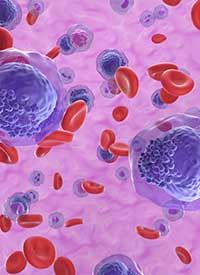SLS009 Plus Venetoclax/Azacitidine Displays Activity, Tolerability in Relapsed/Refractory AML
The addition of SLS009 to the combination of venetoclax and azacitidine produced anti-leukemic effects and was safe in patients with relapsed/refractory acute myeloid leukemia who did not respond or stopped responding to venetoclax-based therapies.

The addition of SLS009 (formerly GFH009) to the combination of venetoclax (Venclexta) and azacitidine (Vidaza) produced anti-leukemic effects and was safe in patients with relapsed/refractory acute myeloid leukemia (AML) who did not respond or stopped responding to venetoclax-based therapies, according to topline data from the phase 2a portion of a phase 1/2 trial (NCT04588922).1
Findings showed that among 5 patients enrolled and treated with the safety dose level of 45 mg of SLS009, 1 patient experienced a complete response (CR) and remained in the fifth month of study treatment following previous relapse on venetoclax treatment. All 5 patients were alive at the time of data cutoff, and treatment was ongoing for 4 patients.
Notably, anti-leukemic effects were documented in all 5 patients, and no significant safety issues were reported.
“This outcome may represent a long-awaited breakthrough in treating patients refractory to venetoclax combination therapies after multiple lines of treatment,” Omer Jamy, MD, a principal investigator and an assistant professor of medicine at O’Neal Comprehensive Cancer Center at the University of Alabama at Birmingham (UAB) and associate director of the Bone Marrow Transplant Program at UAB, stated in a news release.
“Almost all older AML patients in the United States are treated with venetoclax combinations at some point during their course of treatment and, unfortunately, the majority of them become resistant to venetoclax with limited options thereafter. Survival of those patients with currently available treatment options is approximately 2.5 to 3 months. Based on what we have seen to date in this phase 2a study of SLS009, we have managed to reverse this resistance to therapy and, equally important, extend survival in addition to a very good safety profile and quality of life. I hope to see continuation of this pattern in other patients enrolled later.”
On October 11, 2023, the FDA granted an orphan drug designation to SLS009—a novel, small-molecule, highly selective CDK9 inhibitor—for the treatment of patients with AML.2
The phase 1/2 trial is evaluating SLS009 alone in patients with relapsed/refractory AML and other hematologic malignancies, and in combination with venetoclax/azacitidine in patients with relapsed/refractory AML.3 All patients are required to be at least 18 years of age with cytologically or histologically confirmed relapsed/refractory hematologic malignancies, including AML, chronic lymphocytic leukemia/small lymphocytic lymphoma, and lymphoma.
Key requirements for patients with lymphoma include at least 1 measurable or evaluable lesion per 2014 Lugano response criteria and at least 2 prior lines of systemic therapy. Patients with AML being enrolled to the combination cohort must to be relapsed/refractory to prior venetoclax-based regimens.
For all patients, key exclusion criteria consist of bulky disease of at least 10 cm requiring cytoreductive chemotherapy; symptomatic central nervous system (CNS) metastases or primary lymphoma, including primary CNS lymphoma, leptomeningeal disease, or spinal cord compression; and severe cardiovascular disease within 6 months of enrollment.
In the phase 2a portion of the study, patients with relapsed/refractory AML are being treated with SLS009 at doses of 45 mg or 60 mg once per week in combination with azacitidine and venetoclax.2
Safety and tolerability are serving as the trial’s primary end points. Secondary end points are comprised of pharmacokinetics, complete response rate, duration of response, progression-free survival, and overall survival.3
Previous data from the phase 1 portion of the study showed that SLS009 monotherapy elicited a CR in 1 patient with relapsed/refractory AML, and this patient was alive for 11 months as of the most recent follow-up.1Among patients with relapsed/refractory AML treated during the phase 1 portion (n = 31), 94% (n = 29) were alive as of May 2023.
Topline phase 2a data for the recommended phase 2 dose of 60 mg of SLS009 are expected to read out before the end of 2023.
“This initial outcome that includes a CR, anti-leukemic activity in all patients, good safety profile across the patients, and indications of extended survival for our enrolled patients still continuing treatment, we believe opens multiple registrational opportunities for SLS009,” Angelos Stergiou, MD, ScD hc, president and chief executive officer of SELLAS, said in a news release.
“While these results are early, they are extremely encouraging and consistent with the phase 1 study results, and further strengthen our initial proposition that the addition of CDK9 inhibition in combination with BCL-2 inhibition and hypomethylating agents could provide patients with a triple hit to increase response rates and survival outcomes without sacrificing safety and tolerability due to the specificity of SLS009. We look forward to providing additional updates this quarter from this study.”
References
- SELLAS announces positive initial topline phase 2a data of SLS009 in acute myeloid leukemia. News release. SELLAS. October 16, 2023. Accessed October 17, 2023. https://www.sellaslifesciences.com/investors/news/News-Details/2023/SELLAS-Announces-Positive-Initial-Topline-Phase-2a-Data-of-SLS009-in-Acute-Myeloid-Leukemia/default.aspx
- SELLAS receives FDA orphan drug designation for SLS009 for treatment of acute myeloid leukemia. News release. SELLAS. October 11, 2023. Accessed October 17, 2023. https://www.sellaslifesciences.com/investors/news/News-Details/2023/SELLAS-Receives-FDA-Orphan-Drug-Designation-for-SLS009-for-Treatment-of-Acute-Myeloid-Leukemia/default.aspx
- A study of GFH009 in patients with hematologic malignancies. ClinicalTrials.gov. Updated September 1, 2023. Accessed October 17, 2023. https://classic.clinicaltrials.gov/ct2/show/NCT04588922



